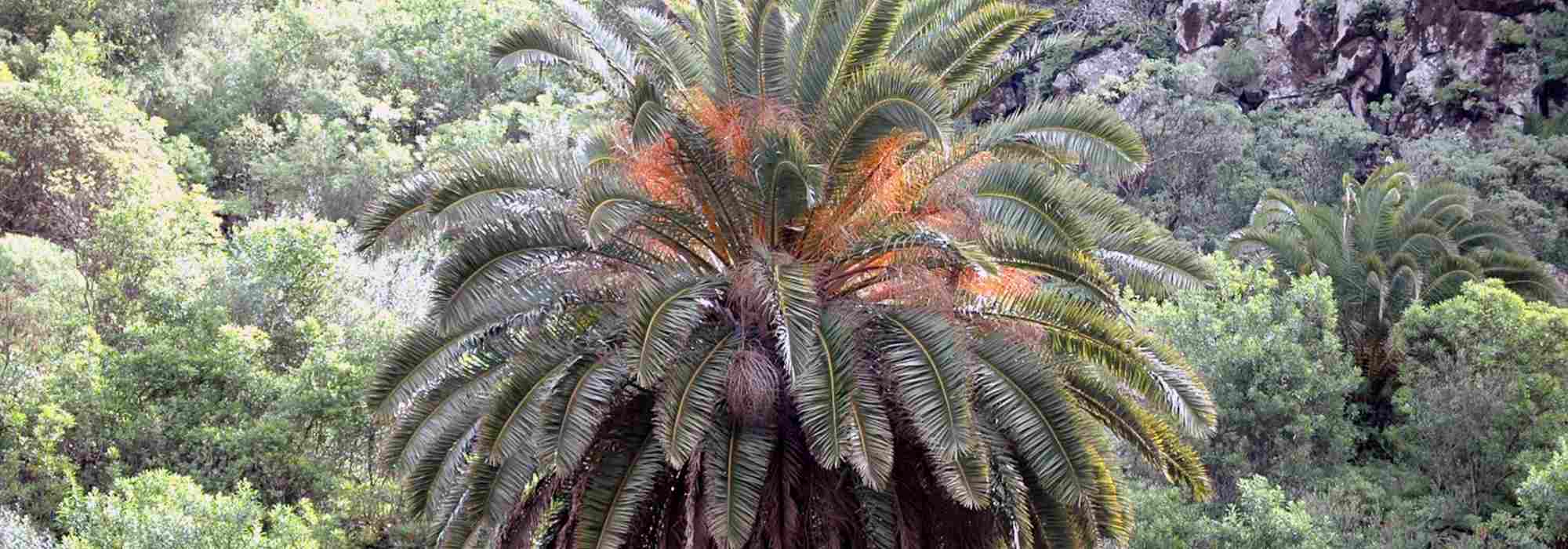
Phoenix: planting, growing and care
Contents
Phoenix in a nutshell
- Phoenix is a stunning palm that adds exoticism to our decor
- It is appreciated for its large, gracefully arching fronds, a rich emerald green
- It comes in several species, all more ornamental than the others
- Frost-sensitive, it thrives in the ground in gardens spared from frost, in pots to protect against winter frosts elsewhere
- It enjoys sunny exposures and well-draining soils
A word from our expert
The Phoenix palm is the perfect plant to bring a touch of exoticism to both your garden and your home! With a sturdy trunk topped by a magnificent crown of elegant foliage, it captivates with its very characteristic palm silhouette. From Phoenix canariensis or Canary Island date palm, also known as the “false date palm,” which is a must-have on the Côte d’Azur, to Phoenix roebelenii or dwarf date palm, highly valued as an indoor plant since it does not exceed 2.50 metres in height, this palm adapts well to large gardens as well as to cultivation in very large pots.
As it fears frosts below -7°C, or even -10°C in very well-drained soil, its cultivation in open ground is reserved for mild climates and coastal gardens. Elsewhere, it makes a stunning orangerie plant.
It requires sunlight, warmth, air, and space, and grows quickly if it has enough water and nutrients. It thrives in fertile, deep, and light soils.
Discover this superb palm for mild gardens or interiors!
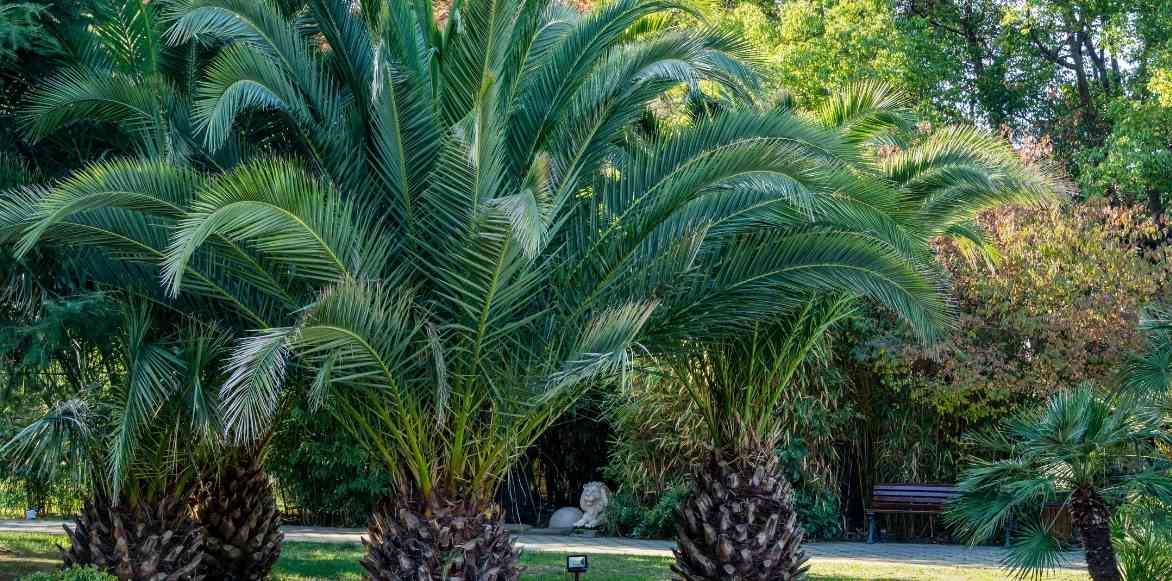
Phoenix canariensis
Description and botany
Botanical data
- Latin name Phoenix
- Family Arecaceae
- Common name Dwarf palm, True date palm, False date palm, Canary Island palm
- Flowering June to August
- Height 2 to 10 m
- Exposure Sun
- Soil type rich and light
- Hardiness variable depending on species
The genus Phoenix comprises 17 species of palms belonging to the vast family Arecaceae. They are native to many regions around the globe, including the Canary Islands, Africa, Crete, the Middle East, India, and Indonesia. In the wild, they can be found in a variety of environments. They grow spontaneously in copses or in open subtropical forests, not far from shores or in the beds of dried-up rivers, or even on sloping terrain.
The Phoenix is one of the most commonly cultivated palms in our climates. It is valued for certain species that are collectively referred to as “date palms.” Among the Phoenix, the most commonly cultivated species is the famous Phoenix canariensis or Canary Island date palm, also known as the “false date palm”: it is one of the most widely planted palms in all regions of the world, alongside Phoenix dactylifera (or date palm), renowned for its numerous cultivars, including the famous ‘Medjool’. Here, they are primarily found on the Côte d’Azur. Alongside these majestic specimens, several other species, all more ornamental than the last, can be found, such as Phoenix andamanensis, the Phoenix roebelenii or dwarf date palm, one of the best indoor palms, and the picturesque Phoenix theophrasti, endemic to Crete, which is the only palm native to Europe.
The appearance, height, and habit of Phoenix palms vary greatly depending on the species. These palms develop slowly during the first three years, after which growth accelerates, as is the case with most palms, especially if they are well-watered. They have a respectable longevity, living up to 300 years. In their native habitat, they can reach heights of up to 30 m. In our gardens, under favourable climate and soil conditions, they can reach a maximum height of 13 to 15 m at maturity. Some smaller species do not exceed 2 to 3 m in height. In pots, they will maintain more modest dimensions.
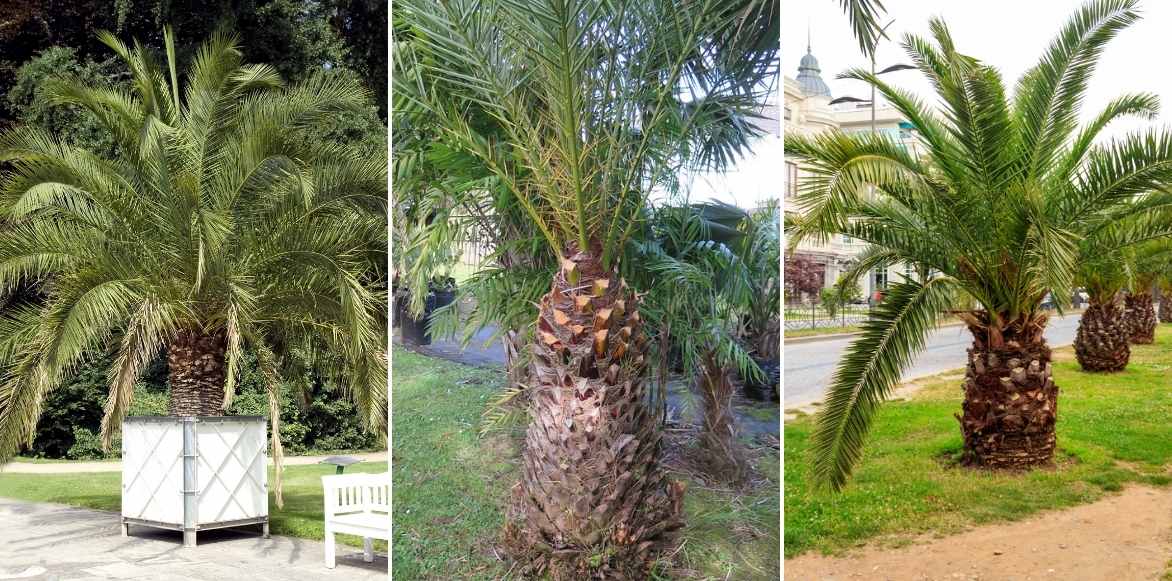
Phoenix canariensis, Phoenix theophrasti, and Phoenix roebelenii
The habit is tall and very graceful in Phoenix andamanensis, stocky in the Cretan date palm, and even stockier in Phoenix canariensis.
Like other palms, Phoenix palms are not trees. They are characterised by a solitary or multiple stipe or false trunk, depending on the species. The stipe can reach up to 80 cm in diameter at the base. It is most often covered with brown fibres and marked by the bases of old petioles that have been cut or have fallen off. The Phoenix andamanensis is distinguished by its smooth stipe.
At the top of each stipe, a crown of numerous evergreen leaves unfolds, which are very large, thick, and leathery. The leaf crown is composed of 30 to over 150 long fronds, which are called leaves. It is more or less leafy depending on the species. These long, gracefully arching fronds add a lot of exoticism. They are pinnate and take on a feather-like or fishbone shape, unlike other palms that bear palmate leaves. They are divided, cut into many fine but fairly wide leaflets or pinnules, pleated in a “V” shape and arranged irregularly along the central vein. They are sometimes pointed at the tip and spiky, measuring between 1 and 7 m in length and sometimes over 2 m in width. Each is attached to the stipe by a long petiole edged with thorns.
The foliage is a bright green, sometimes a grey-blue-green. It remains decorative in winter, and each leaf has a lifespan of about 3 to 7 years.
Flowering occurs in summer, on mature plants, after many years of cultivation. The Phoenix is a dioecious species, meaning there are male and female plants. The inflorescences arise between the leaves. They take on a different appearance depending on whether they are male or female individuals. Male plants produce short, cream-yellow flowers, while female plants have longer, pendulous flowers.
These small flowers are followed by fruits. Only female plants produce dates, provided there are male plants nearby. However, they are nothing like the “true date palms” of the oases (Phoenix dactylifera)! Our “false date palms” produce clusters of fruits that are initially orange or red, turning brown at maturity, which are primarily of decorative interest. Each fruit contains a single elongated seed, marked by a groove like that of dates. Under our climates, including in the south of France, Phoenix palms do not produce or produce very few dates, and when they do, they are of poor quality. Although edible, their flesh is very dry and not very tasty.
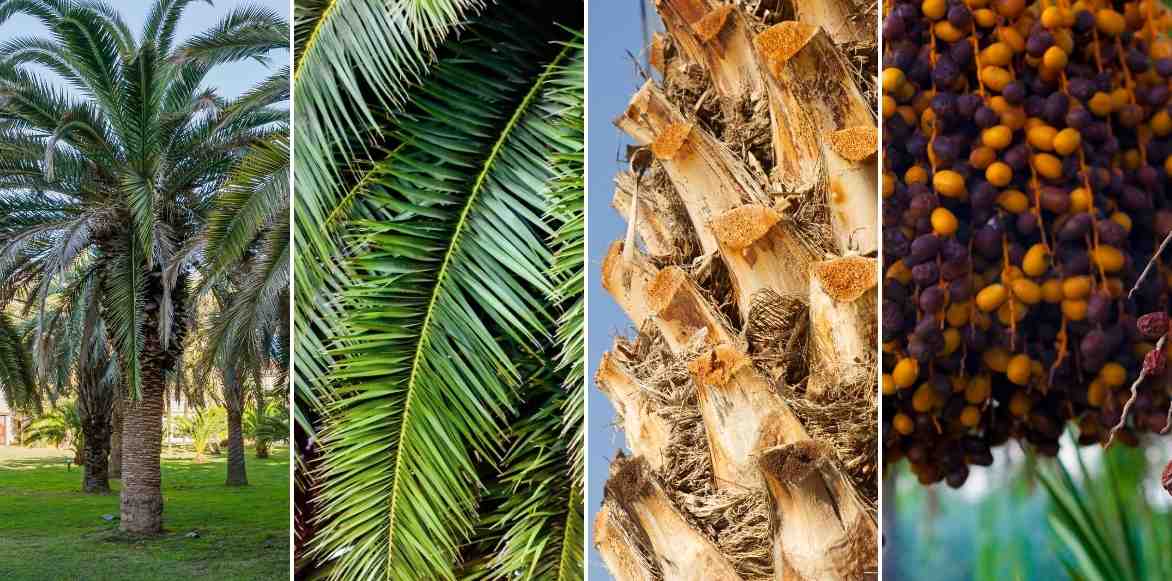 Phoenix canariensis: habit, foliage, stipe, and fruits[/caption>
Phoenix canariensis: habit, foliage, stipe, and fruits[/caption>
“`
Main species
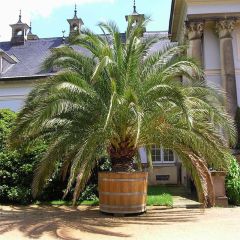
Phoenix canariensis - Canary Island Date Palm
- Flowering time August, September
- Height at maturity 15 m
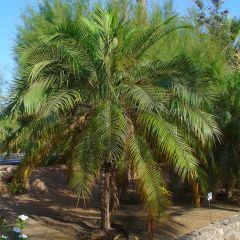
Phoenix roebelinii
- Flowering time August, September
- Height at maturity 2,50 m

Phoenix theophrasti - Cretan Date Palm
- Flowering time August, September
- Height at maturity 16 m

Phoenix andamanensis
- Flowering time August, September
- Height at maturity 10 m
Discover other Phoenix
View all →Available in 5 sizes
Available in 2 sizes
Available in 2 sizes
Available in 1 sizes
Available in 1 sizes
Available in 1 sizes
Available in 1 sizes
Planting the Phoenix
Where to plant it?
Some species of Phoenix do not tolerate negative temperatures, while others, such as Phoenix canariensis and Phoenix theophrasti, can withstand short frosts of around -7, even -10°C, once well established. This is why planting them in the ground should be reserved for our mildest regions, generally only on the Côte d’Azur, or in certain more sheltered areas of the Atlantic coast. Elsewhere, the Phoenix should be grown in a very large pot to be wintered away from frost or can make a beautiful indoor orangery plant, in a very bright spot, in a cold greenhouse or conservatory (between 10 and 13 °C in winter). Indoors, it prefers a filtered light exposure, protected from the scorching rays of the sun. In a pot, it will maintain more modest dimensions.
When grown in the garden, it requires full sun and warmth, both of which will promote faster growth. In regions spared from frost, the ideal is to plant it in well-draining soil, slightly cool in summer, and rather dry in winter. Place it in the sun, in ordinary, well-tilled, humus-bearing, and well-drained soil, in a location protected from cold, dry winds. This sensitive plant fears stagnant moisture at the roots, especially when combined with cold. If your soil is rather heavy and clayey, do not hesitate to improve drainage at planting. However, it tolerates drought well once established.
As it is a palm of considerable size, provide it with a location that matches its development.
In the ground, it integrates perfectly at the centre of an exotic bed, as a solitary specimen on a lawn, or in alignment. It makes a striking impression near a swimming pool.
In a pot, it will add a magnificent exotic and refreshing touch!
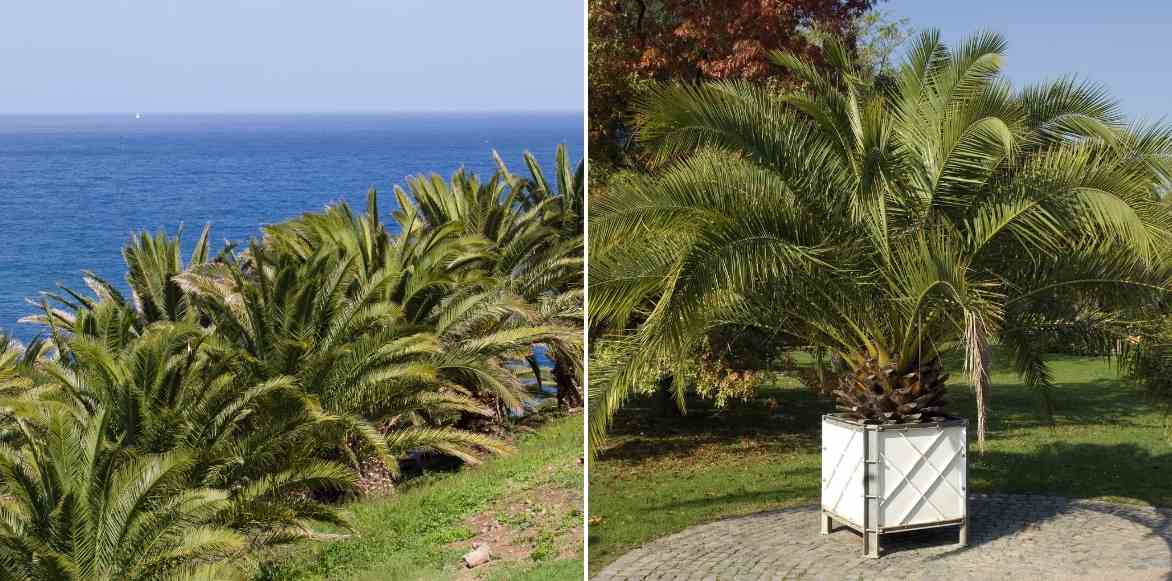
The Phoenix thrives in coastal regions or the Côte d’Azur, or in pots elsewhere
When to plant?
The Phoenix is planted in the garden in spring from March to June after the frosts, or in late summer in mild climates, but in this case, do not plant too late as it needs warmth to establish well.
How to plant?
In the ground
If your soil tends to retain water, improve drainage by adding coarse sand or gravel, or by planting your palm on a mound, so that water can drain away quickly.
- Prepare a hole 2 to 3 times the volume of the root ball
- Spread a good layer of gravel or clay balls at the bottom of the hole
- Plant the palm upright in the centre
- Fill in with a mixture of 50% garden soil, 25% coarse sand, and 25% compost
- Avoid burying the base of the stipe
- Lightly compact
- Water generously
- You can apply mulch around the base to keep the soil cool
In a pot
The Phoenix grows very well in a pot, to be placed on the terrace in summer and brought in to protect from frost in winter.
- Choose a large, deep pot of at least 60 cm in diameter with drainage holes
- Install a good drainage layer at the bottom
- Plant your palm without burying the collar in a well-draining substrate made of garden soil, potting mix, and sand
- Water generously
- Place it in a sunny location
Growing and aare of Phoenix
In the ground
This palm prefers soil that remains cool in summer. Water regularly during the first three summers in the garden to help it establish well, especially in hot and dry conditions. Throughout the growth period, from May to September, water weekly without allowing the root ball to dry out between waterings. For the rest of the year, it will rely on rainfall. In winter, water only if rainfall is scarce. Over time, this palm becomes more drought-resistant.
Add some crushed horn in spring and summer by scratching it into the base of your palm.
Mulch your Phoenix, especially during the first two or three years, to keep its roots cool in summer and warm in winter. To protect it from winter frosts, wrap its fronds in hessian or a winter fleece. It will appreciate this winter protection against the cold. Young Phoenix palms are more sensitive to cold than mature specimens.
Prune the oldest, faded, and damaged fronds close to the trunk as needed.
In a pot
Water regularly, about once a week during the growth period, allowing the substrate to dry out before watering again to prevent root rot. Mist the foliage regularly to remove dust and deter mites. From May to September, apply a liquid fertiliser to the watering water every 10 days.
For winter, bring your pots into a greenhouse or indoors (ideally at 10-15°C) if you live in a cold region. Place them in a bright location, but out of direct sunlight. Remember to ventilate the room regularly. You can take them back outside in spring after the last frosts. Reduce watering in winter to once every 15 days—always allowing the substrate to dry out a bit between waterings—and stop fertilising.
Repot every 2-3 years in spring to refresh the substrate and place it in a slightly larger pot. You can also simply top up every year by adding a layer of compost about 4 cm thick.
Diseases and pests
Naked crown that collapses, falling fronds, drying or perforation; in the garden, there are two main pests that attack large palms like the Phoenix:
- The Red palm weevil (Rhynchophorus ferrugineus) or “palm killer”. The larvae of this beetle species, which originated from Southeast Asia and has contaminated the entire southeast of France since 2006, burrow into the heart of the trunk and the leaves. Fronds that are cut, dried, or yellowing are a true scourge for plants grown in the ground. Their attacks are fatal. The presence of the Red palm weevil must be reported to the local authorities. A special treatment must be implemented on contaminated plants. To learn more, read our advice sheet: Controlling the red palm weevil.
- The caterpillar of the formidable and widespread Paysandisia archon, a large moth that comes from South America and is found as far as England. It attacks the trunk and leaves, which tend to yellow and dry out. Specific treatments, usually based on nematodes, are available as a preventive measure. For more information on the subject, read: “The palm moth, Paysandisia archon: control and treatment”.
Indoors, Phoenix palms are more susceptible to attacks, especially in a dry and poorly ventilated atmosphere. They can be attacked by red spider mites. In this case, you can mist the foliage, as they dislike humidity.
The mealybugs leave small cottony white clusters on the leaves: remove them with a cotton pad soaked in 90°C alcohol and spray with rapeseed oil.
Multiplication
The Phoenix is propagated by sowing, but this process takes time. You will need to wait 3 to 4 years to obtain a viable and robust young plant. Fresh seeds should be soaked overnight in warm water before being sown in spring in a tray filled with a mixture of turf and damp sand. Place in a heated greenhouse at temperatures between 20 and 25°C. Water with a fine spray. Position your sowings in a bright location. After 6 to 8 weeks, the date stones will germinate. Transplant the young plants into 8 cm diameter pots filled with compost. Water moderately, and be patient!
It is also possible to propagate the Phoenix by separating the offsets that appear at the base of the plant when they are still young. Place each offset in pots filled with potting soil and fill in by pressing down well. Water regularly and place the pots in a bright location, out of direct sunlight. You can then transplant the young shoots into larger pots when they are strong and vigorous.
Associating
With its majestic foliage and habit, the Phoenix creates an exotic and lush atmosphere. For a refreshing decor, surround it with other plants that have an exotic appearance, although it often stands well on its own due to its strong personality.
Pair it with the Yucca, Japanese banana plants (Musa basjoo), a Jubaea chilensis or Chilean Coconut Palm. In a Mediterranean-style garden, it will also complement Cycas or a Wollemi Pine.
You can plant small evergreen bushes at its base, such as Jerusalem Sage, Santolina, teucrium, a carpet of thymes, or simply sow California Poppies there.
In a contemporary garden or a more mineral composition, it pairs well with Phormiums, Agaves, and Nolina nelsonii, plants with remarkable graphic forms and superb grey-blue foliage.
In a large rockery in a mild climate, surround it with Astelia chathamica, a remarkably graphic perennial, or Hakonechloa macra ‘Aureola’, a sumptuous grass with variegated green foliage striped with gold. In their presence, they will brilliantly structure this exotic composition.
It can also be placed in a very large pot on the terrace or right next to a pool!
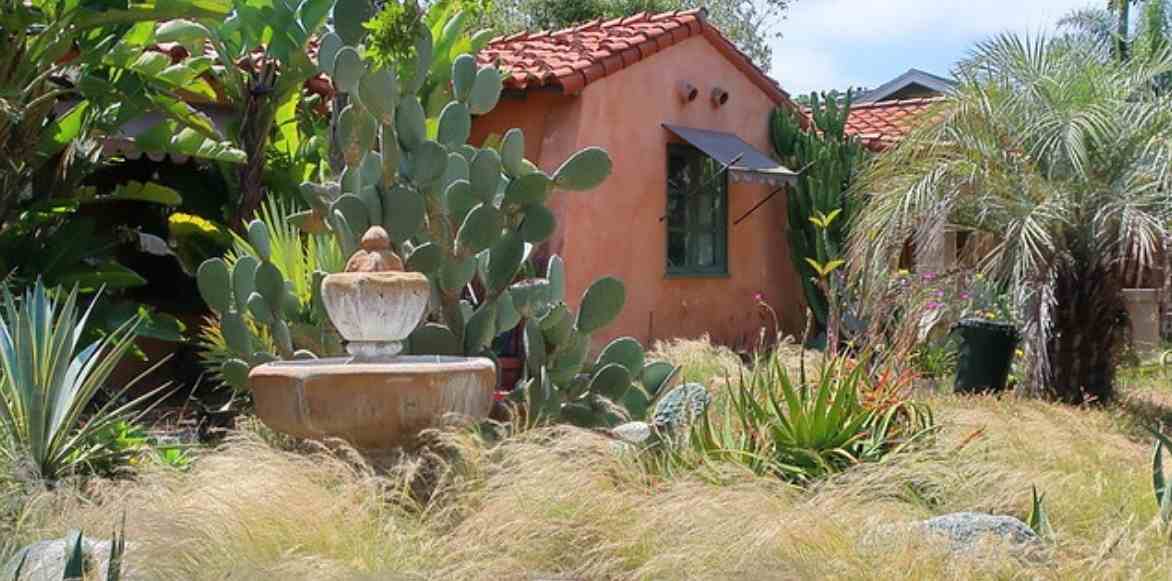
An almost Mexican decor with Phoenix roebelenii on the right, Agave tequilana ‘Sunrise’, Nassella tenuissima planted en masse, Opuntia ellisiana, Strelitzia nicolai (© KM)
Useful resources
- How to compose an exotic garden?
- Discover our exotic plants!
- Tutorial: How to dry dates?
- Our article: Palms by climate
- Subscribe!
- Contents
































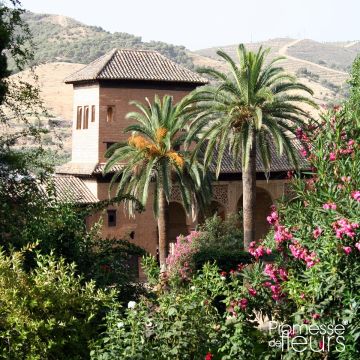

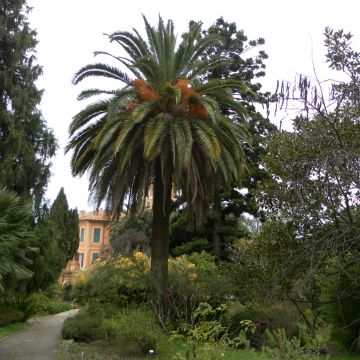
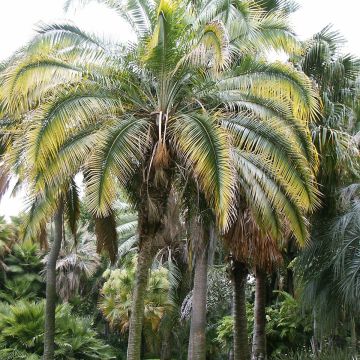


Comments